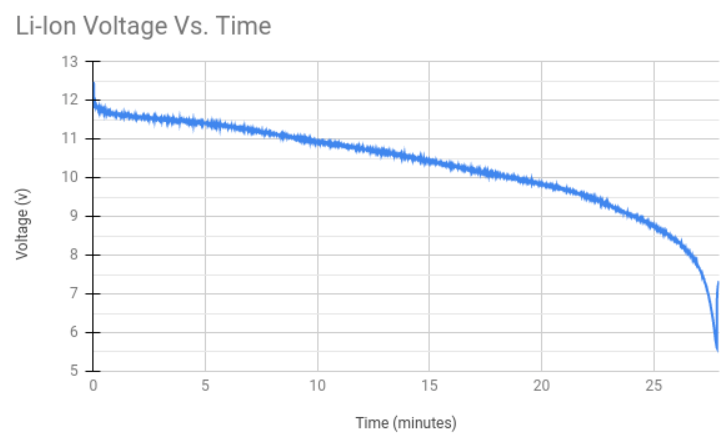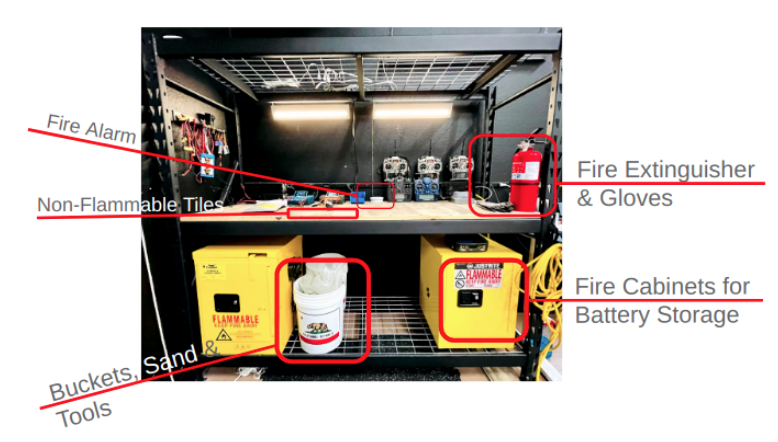Five Essential Components of High Flying Drones: Batteries
Written by Rich Martin
With over 20 years of combined experience as sUAS operators, the flight testers at ModalAI sure know their way around a drone. In their new series, learn about five essential components of high flying drones you should be familiar with in order to have a successful flight every time.
- GPS
- Radios and Datalinks
- Batteries
- Motors
- IMUs & Magnetometers
Here at ModalAI, we primarily use LiPoly (Lithium polymer) for our m500 platforms and Lithium Ion for our smaller drones. Lithium Polymer batteries have become very popular in the drone world because they are lightweight, inexpensive, readily available in a variety of sizes, capacities, voltages, and have high current rates. Lithium Ion is useful because they have high energy densities that are great for smaller endurance drones and fixed wing designs.
In this ModalAI essentials installment, we will help you understand and choose the perfect battery for your high flying drone designs. We’ll also share some tips on how to keep you, your flight team and drone safe!
Battery Specifications
Overview
The battery you choose is derived from the motors and propellers you choose. The motors and propellers you choose depend on the size of your drone. Using the manufacturer’s motor specifications, you can determine the battery specifications for your specific drone.

Figure 1: Motor specification test data from T-Motor parameter page.
The chart above lists the specifications of the MN3508 motor manufactured by T Motor. These specifications are usually available by motor manufacturers to help you select a drone motor and power system. For example, if we build a drone that that weighs 1.4 KG (4 motors), the 14*4.8 propeller will allow our drone to properly hover (50% throttle). This propeller section shows us that a 14.8v battery will use 6.3A per motor, so it would be important to find a battery that supplies 25.2A to be safe, although, we will be likely on average closer to 65% throttle power consumption a majority of the time.
At ModalAI, we use the Dynamometer Thrust Stand by Tyto Robotics (formerly RCBenchmark) to test different motor-propeller combinations and dial in voltage and current requirements. In another installment in this blog series, we go deeper into motors and propellers.
Shown below are sample batteries with called out specs that I’ll cover in more detail in the next section.
Figure 2: Product photos and specifications excerpt from Tattu/Gens Ace product page.
S Rating and Voltage
The first battery specification is the ‘s’ rating, which stands for series noting how many cells are packed in series. The table below shows the s rating with the corresponding number of cells with the associated voltage scenarios for Lithium Polymer batteries.
|
S Rating (# cells) |
Nominal Voltage |
Fully Charged Voltage |
Recommended Loaded Discharge Voltage |
Recommended Resting Discharge Voltage |
Fully Discharged Voltage |
|
1s |
3.7v |
4.2v |
3.5v |
3.7v |
3.0v |
|
2s |
7.4v |
8.4v |
7.0v |
7.4v |
6.0v |
|
3s |
11.1v |
12.6v |
10.5v |
11.1v |
9.0v |
|
4s |
14.8v |
16.8v |
14.0v |
14.8v |
12.0v |
|
Ns |
N*3.7v |
N*4.2v |
N*3.5v |
N*3.7v |
N*3.0v |
Table 1: Lithium Polymer cell ratings and associated voltage scenarios.
Each LiPoly cell has a nominal (or average or operational) voltage of 3.7v and since they are in series, every additional cell just adds another 3.7v to the total battery voltage. The charged voltage per cell is 4.2v, although during use the voltage quickly moves to the nominal voltage and stays there for a majority of operation.
|
S Rating (# cells) |
Nominal Voltage |
Fully Charged Voltage |
Recommended Loaded Discharge Voltage |
Recommended Resting Discharge Voltage |
Fully Discharged Voltage |
|
1s |
3.7v |
4.2v |
2.7v |
3.0v |
2.5v |
|
2s |
7.4v |
8.4v |
5.4v |
6.0v |
5.0v |
|
3s |
11.1v |
12.6v |
8.1v |
9.0v |
7.5v |
|
4s |
14.8v |
16.8v |
10.8v |
12.0v |
10.0v |
|
Ns |
N*3.7v |
N*4.2v |
N*2.7v |
N*3.0v |
N*2.5v |
Table 2: Lithium Ion cell ratings and associated voltage scenarios.
Lithium Ion batteries have the same nominal voltage as LiPoly, but have a Resting Discharge Voltage of 3v, Loaded Discharge Voltage of 2.7v and a fully discharged Voltage of 2.5v. The varying levels in discharge voltage between Lithium Ion and LiPoly batteries are a result of the different chemical properties that make up each battery.

Figure 3: ZOHD 18650 3S Lithium Ion voltage discharge plot recorded during one of our smaller drone’s endurance test flying just over 27 minutes.
In the plot above, you can see a Lithium-Ion voltage curve during one of our smaller drone’s endurance tests. In this test, we wanted to see what is the maximum flight time we could achieve with a 3500 mAH 3 Cell Lithium Ion pack by pushing the limits. At start-up the battery was briefly at the fully charged voltage of 12.6v, then fell to 11.5v then slowly declined over the 27 minute flight. At about 8v, the drone lost thrust and was forced to land. Depending on how much current you draw (number of Cs, covered below), the voltage will drop more rapidly.

Figure 4: 4s GensAce 3300 mAh battery Lithium Polymer voltage discharge plot recorded during m500 endurance test flying just over 22 minutes.
During our real-world LiPo battery test, you can see the fully charged battery around 16.8v discharging close to the 14v threshold with some margin of safety.
Capacity
The battery capacity is represented in milliAmpere Hours or mAH. If you have a battery rated for 3300 mAH, this gives your drone one hour of 3300 mA or 3.3 A of power.
Theoretically, the more capacity you have the longer your drone could fly, but there is a trade-off. Larger capacity batteries may be larger in size and weight, but they could give you more discharge current (higher C Rating) that could be helpful with payloads or windy environments.
Lithium Ion batteries can pack more capacity in a smaller package compared to Lithium Polymer, but comes at a cost of less current or C Rating explained next.
C Rating
The C Rating, also known as the Capacity (or Discharge) rating, tells you how much power or current (Amps) you can draw from the battery continuously. This is a very important rating that will dictate motor and propeller size.
To calculate maximum current draw, use the following formula:
Maximum Continuous Current Draw (Amps) = C Rating * Capacity (mAH)
For example,
45C * 3700 mAH = 166,500 mA or 166.5 A
This is how many amps of current this battery (Tattu 3700mAh 45C 4S1P Lipo Battery) can safely discharge continuously. If you try to discharge at a higher rate, your drone may be underpowered, you could reduce battery life or the battery could ignite on fire.
Some packs may also have a Max Burst C Rating. In this case, the same math holds, except the burst current draw can last for approximately 10 seconds as opposed to continuous.
Battery Maintenance
Charging
Lithium batteries are normally charged at 1C. For example, if we wanted to charge a Tattu 3700mAh 45C 4S1P Lipo Battery at a given amperage:
1C * 3700 mAh = 3700 mA or 3.7 A
Depending on your charger, you will have a couple of different options:
- Balance Charge: This is the recommended option to choose when charging your batteries. The balance charger mode ensures all of the battery cells are charged to the same voltage by monitoring each cell individually.
- Direct Charge: This is the fastest way to charge your battery, without monitoring each individual cell. In this case, the battery could be unbalanced where cells may be charged to slightly different voltages.
- Discharge: This fully discharges the battery, which is helpful in determining the full capacity of a battery. This is especially useful for older batteries where the capacity may have decreased over time.
- Storage: This mode sets each cell of the battery to about ~3.8v or the recommended Lithium battery storage voltage.
Discharging
Battery discharging can affect battery health. In this case, if a battery is overly discharged the battery may not be able to be re-charged again. This can happen if you have your drone at your bench for development work and you forget to monitor the battery or you fly your drone past the recommended loaded discharge voltage. To prevent this from happening, you can install a battery alarm on the balance plug. Using a margin of safety, the voltage per cell should not be discharged below the recommended voltage under load and the recommended voltage under no load. If your pack is ever discharged at or below the fully discharged voltage (LiIon-2.7v, LiPoly-30v) , the pack is likely damaged beyond repair.
PX4 Battery Settings
It’s important to update your flight controller’s battery settings to prevent damaging batteries or prematurely returning to launch (RTL). At ModalAI we use PX4 autopilot to run on our Flight Core®. With knowledge of your battery specifications, you can update your PX4 battery parameters (or similar depending on your flight controller):
|
Name |
Description |
|
BAT1_CAPACITY |
Defines battery 1 capacity in mAh |
|
BAT1_N_CELLS |
Defines the number of cells of battery 1. |
|
BAT1_R_INTERNAL |
Defines the per cell internal resistance of battery 1. |
|
BAT1_V_CHARGED |
Defines the charged voltage of a single cell of battery 1. |
|
BAT1_V_DIV |
This is the divider from battery 1 voltage to ADC voltage. |
|
BAT1_V_EMPTY |
Defines the voltage where a single cell of battery 1 is considered empty. |
Table 3: PX4 Battery parameters. More information on these parameters can be found here.
Health
Battery health is critical for UAVs. A poor battery could result in a failed mission or crash. In our ModalAI pre-flight checklist (downloadable here) we inspect and log our batteries.
When logging batteries we are circumspect to label and keep track of charge cycle number and internal resistance. LiPo batteries can last up to 300 or more charge cycles if properly cared for. After 25 cycles or so, we will log the battery capacity (fully discharged to fully charged) to assess battery health.
Internal resistance (IR) is a great indicator of battery health. We usually measure the internal resistance when the pack is brand-new, mark it on the pack, log it and monitor it over time. Lower IR values are better; as the pack gets older the internal resistance increases. The IR value depends on the capacity of the battery and will differ among types. LiPo batteries with about 1500 mAH capacity are in good condition when measuring approximately 10mΩ or lower IR. Batteries that have cells with significantly higher IR in comparison to the other cells are in poor health.
During our inspection, we look for punctures, cut lead wires, connectors and puffiness. If our battery is “puffy” we take it out of our rotation and discard it. Puffy batteries are very dangerous, since discharging or charging them could cause a fire or some other unforeseeable catastrophe, such as loss of propulsion when landing a 35lb VTOL aircraft from 150ft AGL.
Safety
An ounce of prevention is worth a pound of cure.
When it comes to drone safety, we at ModalAI take it very seriously.

Above is a picture of the ModalAI charging station incorporating our Safety Best Practices and Essentials. Non Flammable tiles reduce the possibility of a fire spreading. Class A:B:C fire extinguisher for all fires besides battery fires. Buckets, Sand and Tools to carefully pick up a battery with fireplace tongs and smother with sand. Fire alarm to alert us if anything catches fire and LiPo bag near the iChargers for batteries being charged. And fire cabinets for battery storage.
We’ve had a couple of LiPo fires at our charging stations due to old puffy batteries. To prevent battery fires from occurring, here are some of our battery handling best practices and items we added the following to our indoor flight test area:
Best Practices:
- Charge batteries only when flight team is close to the testing area
- Transport batteries in a fireproof battery bag with covered leads
- Charge batteries in a fireproof battery bag when practical
- Avoid charging a battery immediately after a flight
- Avoid leaving batteries in a hot car or pelican case after flight
Essential Items:
- Non-flammable ceramic/porcelain tiles on our charging station
- Fire cabinets to store batteries. (We also charge batteries, only when the flight team is close to the testing area.)
- Bucket of sand.
- Fireproof ash bucket with shovel.
- Fire resistant gloves.
- Fireplace tongs.
- Class A:B:C Fire extinguisher to put out all fires besides Lithium battery fires (class D fire extinguishers, which are expensive can be used for combustible metals)
- Fire blanket
- Fire alarm at charging station.
 |
One of our test pilots crashed his personal aircraft. At impact, the battery ignited with a fire shown below that eventually died out. Figure 4: 12s battery fire after R/C helicopter crash. Batteries likely were punctured on ground impact. |
When we had our LiPo battery fires, we quickly moved the battery to a concrete floor, let it burn, allowing it to come slowly to rest. Luckily, they were small batteries and they went out fast after we got them outside.
Battery health inspections are a great way to prevent accidents. Puffiness, punctures, damaged leads, and poor IR must be monitored; if observed, discard.
All Charged Up and Ready to Fly
As drone operators, it’s important to understand the essential components of whatever autonomous vehicles we fly. This foundational knowledge of drone batteries will help reduce troubleshooting time and ensure you have a safe and successful flight every time. Stay tuned for the next blog in this series to learn about IMUs and magnetometers.
Subscribe to our newsletter to be notified of new blogs, products and software releases. We hope this information was helpful and your drones continue to fly high!




